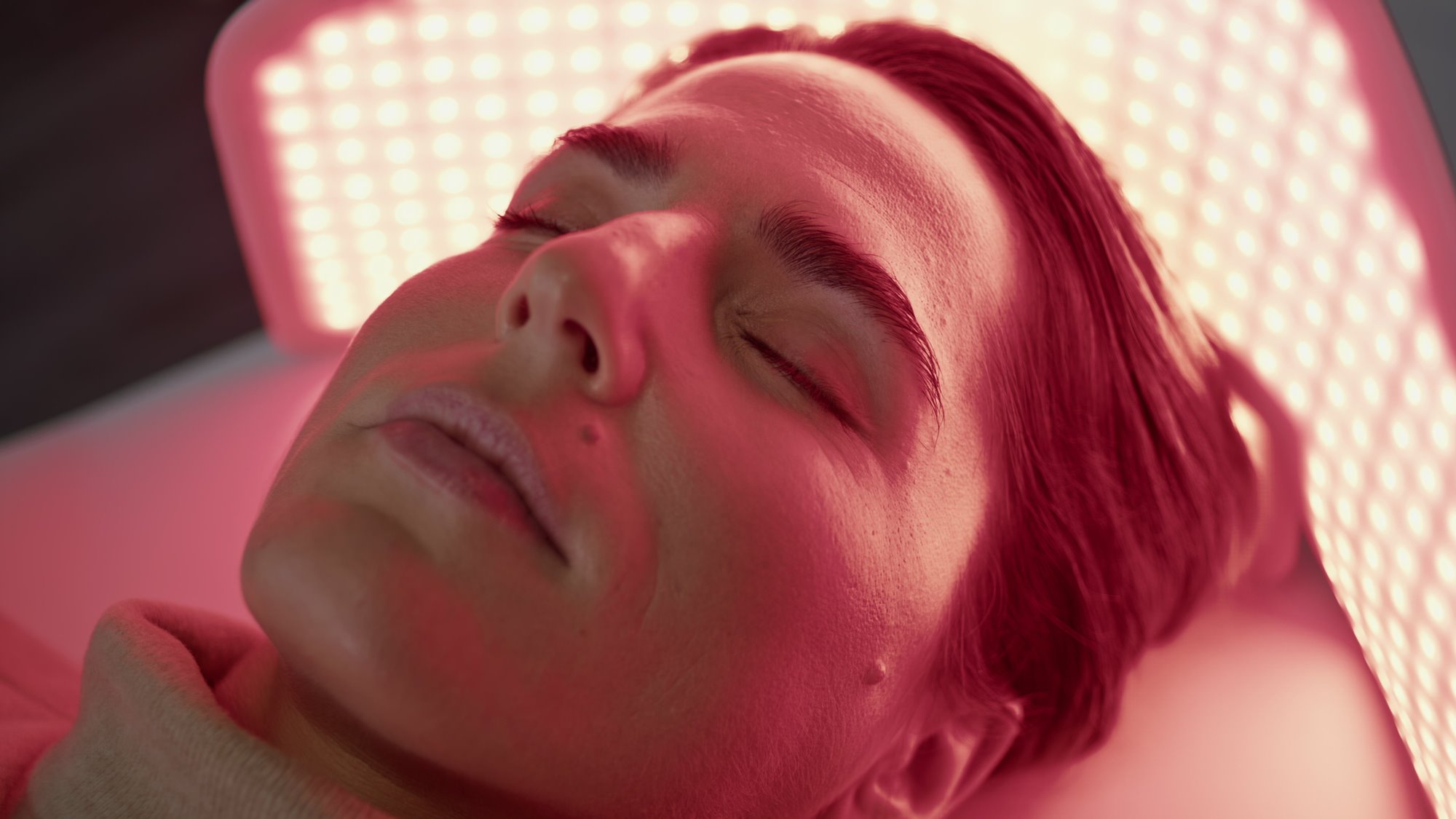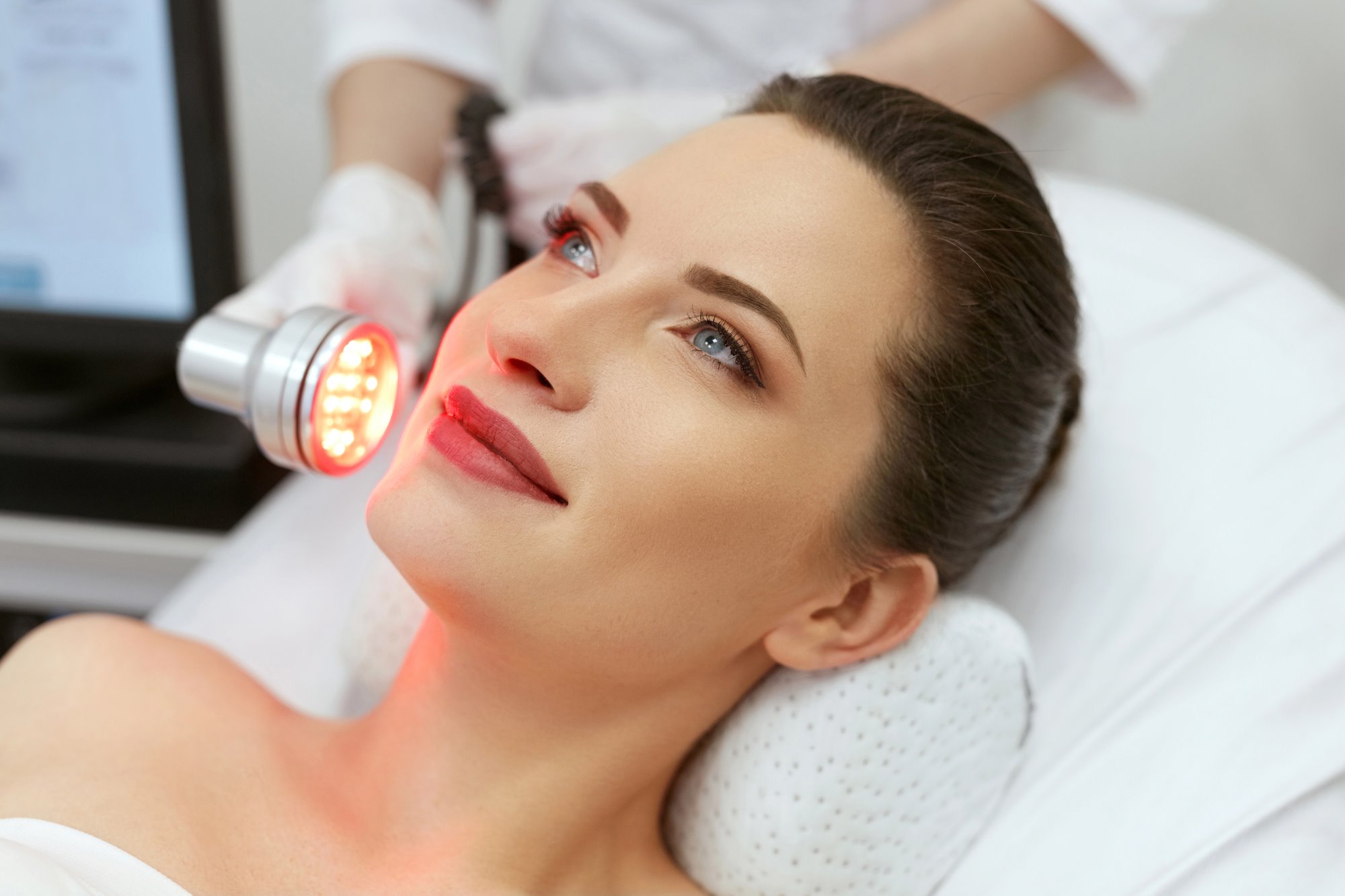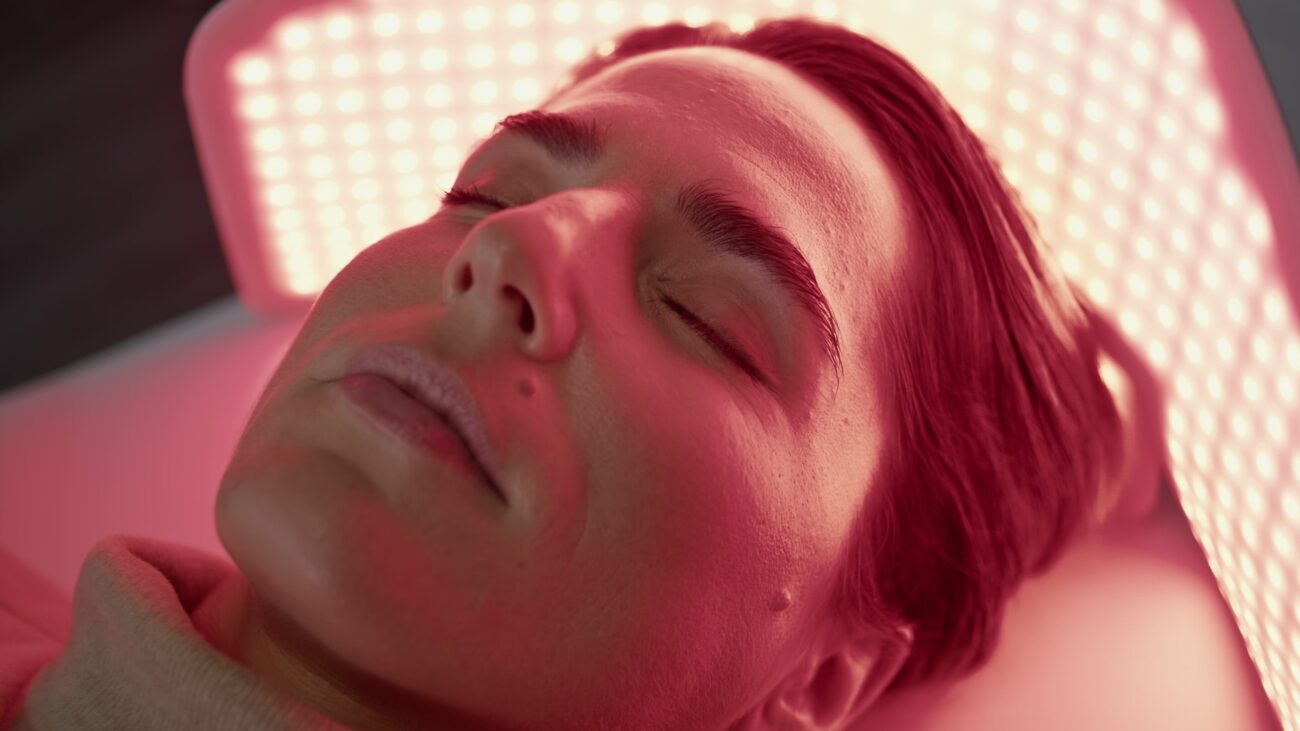
Our skin is exposed to various environmental stressors daily, from pollution to UV rays, leading to premature aging and skin issues. Traditional skincare products can only do so much to combat these effects.
Enter red light therapy, a burgeoning field in dermatological science that harnesses the power of low-level wavelengths to enhance the skin's appearance and initiate deep cellular mechanisms that foster healing and rejuvenation.
If you're looking to take your skincare regimen to the next level, red light skin therapy might be the key. By harnessing the power of red light wavelengths, this non-invasive treatment can stimulate collagen production, reduce inflammation, and enhance skin tone.
Let's delve deeper into how this innovative therapy can transform your skin health for the better.
What's Red Light Therapy?
Red light therapy (RLT), also known as photobiomodulation, is a treatment that employs low wavelengths of red light to penetrate the skin and improve cellular function. This innovative therapy utilizes several light devices that emit specific wavelengths, aiming to catalyze biological processes that are crucial for overall health.
The principle behind this technology is the ability of red light to reach deep into the layers of the skin, where it stimulates mitochondrial activity—the powerhouse of cells. This increase in energy production can significantly enhance cellular repair and rejuvenation.
As the skin absorbs these light wavelengths, they trigger natural biological processes that may lead to improved skin texture, enhanced healing, lower inflammation, and a reduction in various skin conditions.
You'll likely find RLT under several other names, like low-level light therapy, photodynamic therapy, cold laser therapy, low-power laser therapy, low-level laser therapy, soft laser therapy, non-invasive LED treatment (as it uses mostly LED lights to emit the light), or the more verbose atraumatic photobiomodulation treatment.
Whatever the name you'll encounter it under, it presents a means to assist clients in achieving healthier skin without the need for chemicals or invasive procedures.
Overall Benefits of Red Light Therapy
The therapeutic effects of low-level laser therapy offer a diverse range of benefits, from enhancing health to reducing inflammation and promoting muscle recovery. The treatment works by utilizing low wavelengths of red light to penetrate the skin, stimulating cellular repair and increasing circulation.
The very low frequency of the light (infrared light) will not burn or generate heat. Still, it does go deeper than regular light, meaning it can affect your cells in ways that medical researchers have slowly discovered in the last couple of decades through clinical trials and other studies.
Among the benefits of RLT shown in studies and trials are:
- Reduced inflammation and pain
- Enhanced muscle recovery and performance
- Increased circulation and tissue oxygenation
- Enhanced joint health and mobility
- Improved mood, sleep quality, and mental well-being
- Accelerated wound healing or faster healing time
- Boosted immune system function
- Reduce cold sores from herpes
- Pain relief for chronic conditions such as arthritis and fibromyalgia
It should be noted that red light therapy or any form of non-invasive LED treatment does not involve UV rays or any type of intense light source that can cause skin cancer or other problems, like burns.
Some forms of light therapy can also treat Seasonal Affective Disorder (SAD), although the light source is typically a small box at home and does not use red light specifically.
By integrating red light skin treatment into wellness practices, professionals, physicians, and therapists can provide a non-invasive solution that supports the body's natural healing mechanisms, thereby fostering a holistic approach to health and beauty.
Are LED Light Therapy and Red Light Therapy The Same?
While both LED light therapy and red light therapy are popular for several health treatments, the concepts are not exactly synonymous. LED light therapy utilizes a broad spectrum of colors, each corresponding to varying wavelengths that target specific skin issues. Red, blue, and near-infrared are common choices, with each color serving distinct purposes; for example, blue LED light is frequently used to combat acne.
Conversely, red light therapy specifically uses red and near-infrared wavelengths. This form of treatment dives deeper into skin layers to activate and enhance mitochondrial function, which is crucial for energy production and cellular repair. Often referred to as the powerhouses or energy source of the cell, the mitochondria are stimulated, boosting their ability to produce energy (ATP), which is crucial for various cellular functions.
So, the primary focus of red light treatment is the activation of mitochondria, which leads to the production of collagen, which then reduce inflammation, and promote wound healing, making it particularly effective for deeper skin rejuvenation and muscle recovery.
The differences between these therapies also extend to their application and intensity. Light therapy using LED bulbs can be administered through various at-home devices, such as light therapy masks and handheld units, which offer convenience but typically at lower intensities.
Red light therapy, while also available for home use, is often administered in clinical settings to ensure higher intensity and efficacy, guided by professionals who tailor the treatment to individual needs.

Benefits of Red Light Therapy on the Skin
Red light dermatological treatment offers a range of benefits for enhancing human skin health, each backed by years of research and studies. Just to name a few, it is known to stimulate collagen production and increase fibroblast proliferation, both crucial for skin repair and rejuvenation.
Board-certified dermatologists have increasingly relied on several types of photodynamic therapy, in conjunction with other treatments, to achieve a more holistic result that does not rely solely on medications or leaves the patient with few alternatives.
Among the potential benefits of low-level laser light therapy on the skin are:
Stimulates Collagen Production
Stimulating collagen production is one of the key benefits of red light therapy, enhancing skin elasticity and reducing the appearance of aging. As collagen, a vital protein for maintaining the structure and resilience of our skin, diminishes with age, red light therapy offers a non-invasive solution to counteract this natural decline.
By penetrating deep into the human skin layers, red light therapy triggers the natural synthesis of collagen, leading to improved intradermal collagen density and noticeable skin improvements.
There are many anti-aging benefits of increased collagen production, such as helping smooth fine lines and wrinkles, giving the skin a more youthful appearance and better tone, and providing more hydration. It even combats the sagging that comes with aging.
Increase Dermal Fibroblast Proliferation
Another positive effect of light therapy or cold laser therapy is that it promotes the proliferation of fibroblasts, enhancing the skin's ability to repair and rejuvenate itself. Fibroblasts are crucial cells responsible for generating connective tissue and enabling collagen production, which is pivotal for maintaining youthful and resilient skin. Through targeted light exposure, this treatment stimulates cellular functions, boosting not only their quantity but also their efficiency in synthesizing collagen.
The impact of increased fibroblast production and proliferation extends to comprehensive skin rejuvenation because by enhancing fibroblast activity, red light therapy supports the underlying dermal structure. This leads to improved skin durability and a healthier appearance, which is crucial for anyone involved in dermatological health or aesthetic improvement over any age-related skin concerns.
Increase Blood Flow to Skin
How does red light therapy enhance blood circulation in the skin?
As we've already mentioned, the treatment stimulates cellular functions, specifically the mitochondria within cells, known as the powerhouse of the cell, to produce more energy (ATP). An increase in ATP production enhances the functioning of the endothelial cells in the blood vessels, leading to vasodilation or the widening of blood vessels. As a result, there is an improved blood flow within the skin.
Enhanced blood circulation is crucial for maintaining skin health as it supplies essential nutrients and oxygen to the skin cells, promoting cell growth and regeneration. Moreover, better blood flow helps in the effective removal of waste products from cellular processes, which might otherwise accumulate and harm human skin health. Red light therapy, by boosting blood flow, supports these vital processes, ensuring that the dermal layers remain nourished, oxygenated, and healthier.
This method is particularly beneficial for individuals seeking non-pharmaceutical or invasive treatment options to improve skin vitality and appearance.
Treat Inflammatory Conditions
Red light therapy effectively reduces inflammation by modulating biochemical pathways that decrease the production of inflammatory cytokines. By influencing these pathways, red light therapy contributes not only to reducing inflammation but also to overall skin improvements, enhancing both the appearance and health of the skin.
Red light therapy offers a promising option for managing inflammation without the need for pharmaceuticals, which might carry potential side effects. Moreover, the treatment supports the body's natural healing processes, encouraging quicker recovery and better outcomes.
Dark Spots and Acne Treatment
Red light therapy has proven beneficial for treating multiple skin concerns such as acne and dark spots by utilizing specific wavelengths that promote healing and reduce hyperpigmentation.
Particularly, red light therapy is an effective way to treat acne by reducing inflammation and decreasing oil production in the skin. This results in fewer breakouts and a notable improvement in skin clarity.
For those suffering from dark spots, often a result of acne scarring or sun exposure, red light therapy helps by promoting the regeneration of healthy skin cells and diminishing the appearance of these discolorations.
Improve Skin Tone and Texture
Improving skin tone and texture is one of the notable benefits of red light therapy, offering a smoother and more even complexion through enhanced collagen production and cellular rejuvenation.
As mitochondria within the skin cells absorb this energy, they are prompted to create more collagen, a vital protein that plays a crucial role in maintaining skin elasticity and firmness.
The collagen increase not only helps improvements in skin complexion but also enhances the overall texture of the skin, making it appear more youthful and radiant. Regular sessions of red light therapy can significantly aid in skin rejuvenation, reducing the appearance of fine lines and imparting a healthy glow to the skin.
This method of treatment is particularly beneficial for individuals looking to revitalize the effects of time on the skin without the use of harsh chemical peels or invasive procedures.
Help Heal Scars and Psoriasis
Numerous studies have demonstrated that red light therapy can effectively help with the healing process, including reducing the visibility of scar tissue and the effects of psoriasis.
By promoting healthier skin at a cellular level, it supports the skin's ability to protect and repair itself, making it an invaluable tool for maintaining skin health over time.
For individuals grappling with scars, whether from surgery, injuries, or acne, red light skin therapy offers a non-invasive solution to enhance skin improvement and promote a smoother complexion over time.
Potential Help With Hair Loss
Red light therapy has shown potential in addressing hair loss by stimulating hair follicles and promoting regrowth. This innovative treatment harnesses the power of specific wavelengths of red light to penetrate the scalp, energizing the cells within hair follicles. This not only helps in halting the progression of hair loss but also encourages new hair growth. This method is particularly beneficial for individuals experiencing pattern baldness or thinning hair, providing a non-invasive solution to foster hair density and strength.
The benefits of red light therapy in the context of hair restoration are supported by various clinical studies and meta-reviews of studies, which indicate an increase in hair count and improved hair texture following consistent treatment.

The Red Light Therapy Devices Typically Used in Treatment
Red light therapy devices are designed to target specific areas of the body, ensuring precise treatment of skin conditions or muscle pain, or full-body beds that use red light or infrared technology.
There are even full body light devices that act like saunas, filling the small room with ultra-low infrared light that circulation and healing. What stays constant for most of these device types are the wavelengths, as most of any type uses the 630 to 800 Nm wavelengths of light. However, different professionals might use additional wavelengths.
Let's take a look.
Targeted to Specific Areas of the Body
Various devices designed for red light therapy allow for precise targeting of specific body areas in need of treatment.
Handheld light sources, for example, are excellent for concentrating on small areas like the face or joints, providing the exact dosage of red light needed to catalyze healing and improvement. They can also switch to blue light or green light to provide other benefits when using LED light therapy, like the treatment program from ReEnergized.
You'll also see many light or LED masks at many of the healthcare providers that offer RLT. These LED masks target the face to remove signs of aging or any other skin condition in that area.
Larger panels and flexible wraps, on the other hand, can be used to treat broader areas such as the back or legs. These devices are crafted with the intent to deliver uniform light exposure, ensuring that each section of the skin receives adequate attention to stimulate recovery and enhance appearance.
By focusing on specific areas, therapists can efficiently address individual concerns, whether it's reducing the appearance of wrinkles, healing scars, or managing psoriasis.
The versatility of these devices not only makes them invaluable tools in clinical settings but also enhances their utility in spas and wellness centers. By employing these targeted red light therapy solutions, dermatological professionals can provide personalized care that addresses unique skin conditions and different skin types, fosters not only physical healing, and boosts confidence in their clients.
Through Red Light or Infrared Therapy Bed
In addition to handheld devices and panels, full-body red light or infrared therapy beds are commonly employed in treatments to provide extensive coverage and deeper skin penetration. These beds offer a unique advantage by allowing the simultaneous treatment of large areas of the body with a single large light source, which can be particularly beneficial for overall skin health.
The red light emitted by these beds penetrates the skin to stimulate collagen production, enhance cellular repair, and reduce inflammation.
The benefits of red light therapy beds extend beyond superficial skin improvements; they also help promoting wound healing, reduce fine lines and wrinkles, and alleviate chronic skin conditions such as psoriasis and acne.
By lying in a red light therapy bed, users can enjoy a non-invasive treatment that supports the body's natural healing processes and promotes a healthier complexion.
These devices not only provide effective treatment but also offer a relaxing, spa-like experience, making them a valuable addition to services aimed at boosting skin health and overall vitality.
Sessions in Ultra Low Infrared Sauna
Ultra-low infrared saunas represent another form of red light therapy.
Primarily, they help reduce signs of aging, such as wrinkles and fine lines, by promoting increased skin elasticity. Additionally, they offer therapeutic effects for those suffering from skin conditions like psoriasis, eczema, and acne due to their anti-inflammatory properties. Regular sessions can significantly alleviate these symptoms, leading to healthier, more resilient skin.
For individuals dedicated to serving others, understanding and utilizing this technology can be incredibly beneficial. Providing services that include red light therapy through ultra-low infrared saunas can aid in not only enhancing clients' skin health but also boosting their confidence and overall well-being. This makes it an invaluable tool in the repertoire of health and wellness professionals.
Side Effects and Who Should Avoid Red Light Therapy
While RLT is otherwise safe and painless and does not involve UV light, there is some risk that comes from either previous skin conditions or misuse of the light devices.
Among the adverse events possible during red light therapy treatments:
- Eye strain or discomfort: Prolonged exposure to bright lights, including red and LED lights, may cause eye strain or discomfort. It is important to use proper eye protection when undergoing light therapy treatments. If using a light mask, this warning is doubly important. The entire treatment time should be minimal and low-powered.
- Skin irritation: In some cases, individuals may experience skin irritation or redness from exposure to red or LED lights. This can be more common in individuals with sensitive skin or certain skin conditions.
- Headaches: Some individuals may experience headaches or migraines as a result of light therapy treatments. This can be due to the brightness of the lights or the specific wavelengths used.
- Insomnia or disrupted sleep patterns: Light therapy treatments, especially when used in the evening, may disrupt sleep patterns and lead to insomnia. It is important to use light therapy at appropriate times to avoid interference with circadian rhythms.
- Hyperpigmentation: In rare cases, excessive exposure to certain wavelengths of light used in red or LED light therapy may lead to hyperpigmentation or changes in skin pigmentation. This is especially true for people with darker skin tones.
It is important to consult with a healthcare provider or dermatologist before starting any light therapy treatments to discuss the long-term safety any potential risks or side effects based on individual health conditions and skin types.
Certain individuals should also exercise caution or avoid red light therapy treatments altogether due to potential side effects:
- Individuals with a history of cancer. While red light therapy can ameliorate some side effects of cancer treatments, its use by those currently undergoing cancer treatment or with a cancer history should be closely managed under medical advice. The therapy's interaction with cancerous cells is not fully understood, and caution is advised to prevent unintended consequences.
- Photo-Sensitive Skin Conditions: Others who should approach red light therapy with caution—or possibly avoid it—include individuals with skin conditions exacerbated by light exposure.
- Individuals with Darker Skin Tones: People with darker skin tones should be careful about the amount of treatment time they get from RLT. If the dosage of light isn't adjusted, it can lead to hyperpigmentation or other adverse effects.
- Those with Retinal Disorders: Additionally, proper eye protection is crucial during sessions to avoid risks to the eyes, which are sensitive to intense light sources. Without appropriate safeguards, there is a potential for retinal damage or other eye-related issues. Those with light-sensitive conditions, including retinal disorders, should either use specifically designed eye protection or abstain from the therapy, especially from using light masks.
It is always recommended to consult with a healthcare provider to assess personal health conditions and risks before starting any new therapy, ensuring it aligns with individual health needs and safety concerns.
Come to ReEnergized for Infrared and Red Light Therapy for Your Skin
Red light therapy has emerged as a promising, non-invasive treatment modality for enhancing skin health, we learned today. By leveraging the biological effects of low-wavelength red light, this therapy stimulates collagen production, enhances blood circulation, and reduces inflammation, thereby improving skin tone, texture, and overall health.
ReEnergized proudly offers specialized infrared and red light therapy services tailored for skin health enhancement. At ReEnergized, we understand that each individual's skin is unique, and our approach is to provide personalized care that reflects this diversity.
Our dedicated specialists are committed to helping you achieve the best possible outcomes for your skin health, utilizing the latest advancements in red light therapy.
We invite you to visit ReEnergized, where your journey to radiant, healthier skin begins. Our team is ready to assist you in understanding how red light skin therapy can be part of a holistic approach to skincare, ensuring that the benefits align with your personal health and aesthetic goals.
